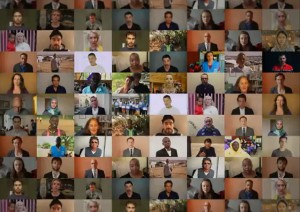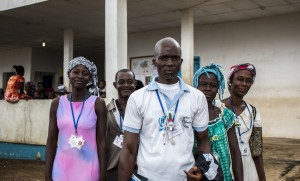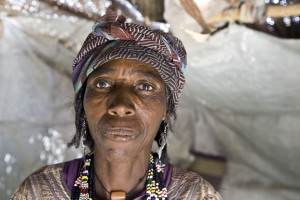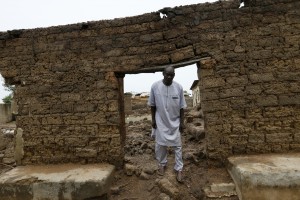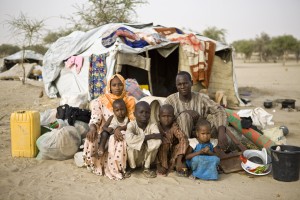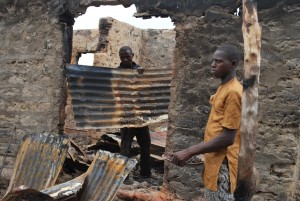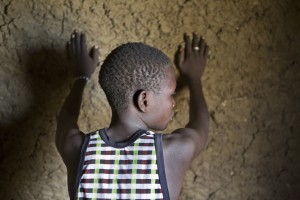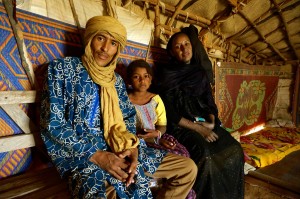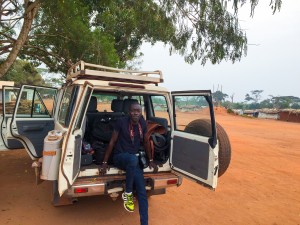Return to Timbuktu
A story of exile and reunion for Malian refugees
Four years ago, a conflict broke out in the north of Mali, pitting government forces against rebel movements, forcing tens of thousands of people to seek refuge in neighboring countries. Today, while more than 140,000 Malians are still in exile in Burkina Faso, Mauritania and Niger, some refugees have decided to return home to their villages and cities, in areas where security has improved in the past months. This is the case for Jafar and his family, who recently left the Mentao refugee camp in Burkina Faso.
TIMBUKTU, MALI, 18 January 2015 (UNHCR) – The end of the day is cool and calm, ideal for sipping a cup of green tea among friends. Jafar, 24, a young Malian of Tuareg origin, savors this Sahelian drink with friends in a schoolyard in one of the many outlying neighborhoods. It is barely a month since he has returned to Timbuktu, also known as the “pearl of the desert,” in this arid region in the north of Mali.
“I come from the city of Gossi, which is part of the Timbuktu Circle. This is my native region. I spent my childhood here before departing in 2008 to Gao to continue my studies.” In Gao, Jafar studied literature. “I was very good in French, so it was quite natural for me to do my baccalaureate in literature.” In high school, he learned quickly and therefore had time for other activities. “In addition to my studies, I was an independent driver for tourists and non-governmental organizations (NGOs) in the region. Thanks to that, I could pay my school fees and provide for my family.”
“I knew I had to leave the country at all costs”
In the beginning of 2012, as he was starting the school year to obtain his baccalaureate in June, he had to change his plans because of the war that broke out in the north of the country. “As soon as the war started, I no longer felt safe at home. I knew that I would have to leave the country using any means possible.” He was 20 at the time and he went by car to Niamey, the capital of Niger.
The road to Niger was the one that then seemed the fastest and safest to him. However, after hearing from his family, Jafar understood that he would not stay in Niamey for long. “When I called my parents, I learned that they had just fled to Burkina Faso. After two weeks in Niamey, I left to meet them”. He then took a bus from Niamey to Ouagadougou, the capital of Burkina Faso, where he arrived after a-ten-hour journey. “UNHCR opened a camp 18 kilometers from Ouagadougou to provide assistance to Malian refugees. I found my family there and we stayed there until it closed.” The Sag-Nioniogo Camp hosted up to 2,813 Malian refugees before closing at the beginning of 2015 for budgetary reasons.
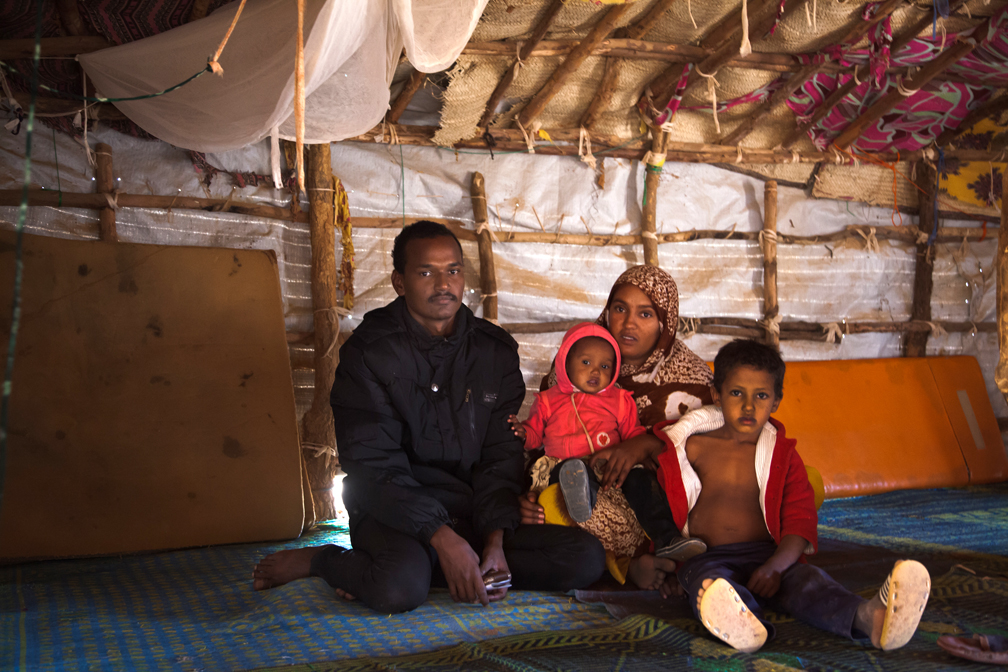
Jafar poses with his wife Zeinabou, their baby daughter Fadimata and they nephew Sidi in their shelter in Mentao refugee camp, Burkina Faso, only days before returning to their homes in Mali. UNHCR / Paul ABSALON
The Malian refugees who chose to continue to benefit from UNHCR’s assistance were then relocated to one of two camps of their choice, located in the Sahel region, in the north of Burkina Faso. “We chose the Mentao camp, since we knew more people there,” explains Jafar. This camp, which is located a few kilometres from the city of Djibo and about fifty kilometres from the Malian border, now hosts 13,000 Malian refugees. UNHCR ensures their legal protection and provides them with essential services (such as water, education, healthcare, shelter). Since 2014, the agency has facilitated the departure of Malian refugees who would like to return to their country of origin. They receive 35,000 CFA francs (USD 70) per individual to help them organize their transportation to Mali, most often by truck or car.
“What I remember from this journey? That security is everything”
At the Mentao Camp, Jafar found safety, but also love and friendship. “I met my wife Zeinabou in the camp, we got married there. That’s also where our daughter Fadimata was born” he adds. “When I left the camp for Mali, I was anxious. Not just because I was taking an unknown route, but also because I did not want to leave a part of my life and close friends behind. We were very close and living together was good. But we wanted to return to Mali more than anything else, and we took my nephew with us, Sidi, whom I consider as my son.

Some 34,000 Malian refugees stay in two camps in Burkina Faso’s Sahel region where they get assistance, including potable water, from humanitarian agencies. Some refugees have started to return to their to return to their country, mainly to the region of Gao, Mopti and Timbuktu. UNHCR / Paul ABSALON
For Jafar and his family, joy marked their return to Timbuktu. “When I left Mali, it was chaos. When I returned, I found a city that had resumed its economic activities. National and international security forces are present, as well as humanitarian ones,” confirmed Tony, for whom the situation that he discovered in his native city was not a surprise. “I was getting news when I was in Burkina Faso. I was in permanent contact with my family members who had stayed in Mali.”
Gossi, Gao, Niamey, Ouagadougou, Sag-Nioniogo, Mentao, Timbuktu… an adventure that lasted nearly five years and that shaped the character and outlook of the young man. “What I remember from this journey? Security is everything. It was a lack of safety that forced us to leave Mali. It is safety that we searched for in Burkina Faso. We found it in the refugee camps. And it is because I knew that Timbuktu had again become safer that we decided to return there with my family.”
Even though some Malian families are choosing to spontaneously return to their native regions in Mali from their exile in neighboring countries – more than 800 repatriated refugees have been verified by UNHCR in the past six months – the security situation in northern Mali remains volatile. If the conflict that shook Mali officially ended with the signature of the Peace Agreement on 15 May and 20 June 2015, terrorist and criminal attacks, as well as human rights violations, persist. Access to some return areas remains a challenge for humanitarian organizations.
And while some refugees, such as Jafar, are able to return to their region, which is now safer, others continue to flee unstable situations and to seek refuge in Burkina Faso, Mauritania or Niger. As a result, more than 4,300 Malians have left Mali since July 2015 to seek refuge in Niger. More than 2,300 Malians arrived in Burkina Faso between January and November 2015, fleeing renewed violence in the north of their country.
Some 40,700 Malian refugees have returned home following their exile
Jafar and his family have since reintegrated into their native community in Timbuktu. “I found my neighbors there, everything was fine with them,” he explained. “Our family has started to come back together with the return of relatives from Burkina Faso.” However, the major concern for this head of household remains the lack of employment to support the needs of his family, especially since his home had been pillaged and destroyed because of poor maintenance. Personal belongings that they had left behind were stolen. But now Tony’s mind is turned towards the future. “We are starting to rebuild it little by little.”
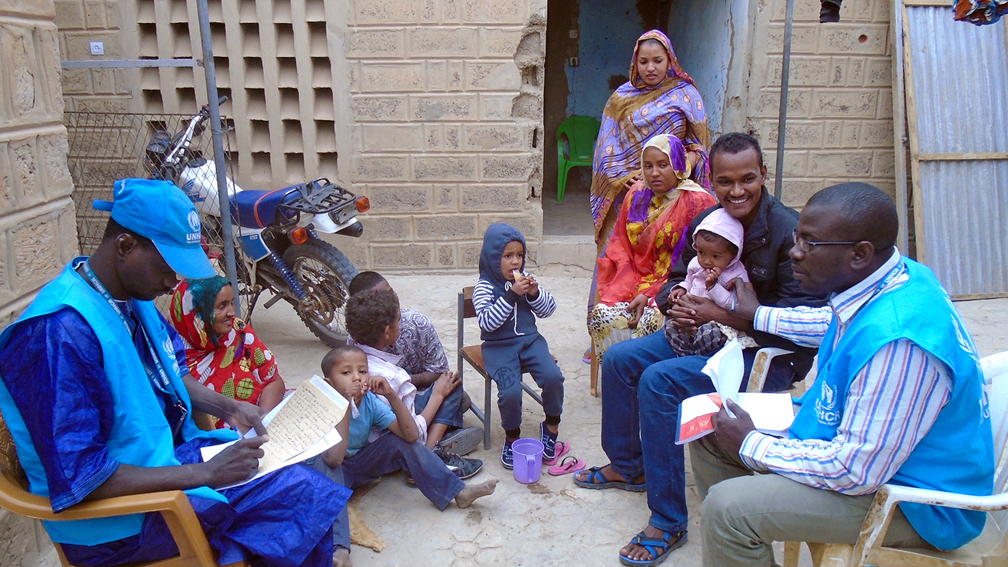
UNHCR officers assess Jafar’s family needs upon their return to their home in Timbuktu. The house has been pillaged and damaged when they were in exile. “We are starting to rebuild it little by little” says Jafar. UNHCR / I. IDRISSA
Limited access to potable water and food in some areas, the high prices of basic goods, as well as limited access to public and administrative services in certain localities has meant that there has only been a timid return of refugees to date. According to the Malian authorities, some 40,700 Malian refugees have returned home following their exile after the crisis broke out in Mali in 2012. More than 17,000 of these returnees have been verified by UNHCR. Most have returned to the regions of Gao, Mopti and Timbuktu.
In the return areas, UNHCR implements community reintegration projects in a certain number of priority communities, such as in Goundam, Gossi, Léré, Soumoundou, Tilemsi and Timbuktu. These projects are aimed at supporting infrastructure that contribute to improving access to education, healthcare, hygiene and water. They help those who have repatriated, as well as the populations who have remained, in order to build peaceful coexistence. UNHCR has also finalized the pilot phase of a financial assistance project for repatriated refugees. In total, in November and December 2015, 4,307 – of whom 1,492 were in Timbuktu – received USD 110 per adult and USD 50 per child. This assistance made it possible for them to start over with a decent life in their area of return and has improved the means of subsistence of many families
With his return home, Jafar now has many plans. He would like to take the baccalaureate exam as an independent candidate, then get a job with the Malian government or an international NGO. “With my high school education and the experience I acquired at the camp, I plan to do humanitarian work. But I no longer have any specific contacts in Timbuktu, so it will be difficult to find a job if I do not have a diploma that reflects my skill level. In the meantime, I need to cover our expenses. My two children have started school again and we have our rent and living expenses. Any work will do for now.” A regular income will also make it possible for him to continue financing his wife’s nursing studies.
140,776 Malians are still refugees in neighboring countries, 34,221 of which are in Burkina Faso, 50,228 in Mauritania and 56,012 in Niger. 61,920 people are still displaced within Mali.
From Isabelle Michal in Bamako and Paul Absalon in Ouagadougou
Translated from French by Erin M. Lyons
Le texte en français:
Retour à Tombouctou
Histoire d’exil et de retrouvailles pour les réfugiés maliens
Il y a quatre ans éclatait un conflit au nord du Mali, opposant forces gouvernementales et mouvements rebelles, forçant des dizaines de milliers de personnes à trouver refuge dans les pays voisins. Aujourd’hui, si plus de 140.000 Maliens sont encore en exile au Burkina Faso, en Mauritanie et au Niger, certains réfugiés décident de rentrer dans leurs villages et villes, situés dans des zones où la sécurité a pu s’améliorer au cours des derniers mois. C’est le cas de Tony et de sa famille, qui ont récemment quitté le camp de réfugiés de Mentao au Burkina Faso.
TOMBOUCTOU, MALI, 18 janvier 2015 - (HCR) – La fin de journée est fraîche et calme, idéale pour un thé vert entre amis. Tony, jeune malien d’origine touareg de 24 ans, savoure cette boisson sahélienne avec un ami dans une cour de l’un des nombreux quartiers périphériques. Cela fait à peine un mois qu’il a rejoint Tombouctou, aussi connue comme « la perle du désert », dans cette région aride du nord du Mali.
« Je viens de la ville de Gossi, qui fait partie du cercle de Tombouctou. C’est ma région natale. J’y ai passé mon enfance avant de partir en 2008 vers Gao pour y poursuivre mes études. A Gao, Tony étudiait les lettres. « J’étais très à l’aise en français, c’est donc tout naturellement que j’ai voulu passer un baccalauréat en littérature. » Au lycée, il apprenait vite et avait donc du temps pour d’autres activités. « A côté de mes études, j’étais chauffeur indépendant pour le compte de touristes et d’organisations non-gouvernementales (ONG) de la région. Grâce à cela, je payais mes frais de scolarité et je pouvais pourvoir aux besoins de ma famille. »
"Je savais que je devais quitter le pays par tous les moyens"
Début 2012, alors qu’il entame son année pour obtenir le baccalauréat en juin, il doit revoir ses plans à cause de la guerre qui éclate au nord du pays. "Dès que la guerre a commencé, je ne me suis plus senti en sécurité chez moi. Je savais que je devais quitter le pays par tous les moyens". Il a alors 20 ans, et parvient à rejoindre Niamey, la capitale nigérienne, en voiture.
La route vers le Niger est celle qui lui parait alors la plus rapide et la plus sécurisée. Mais lorsqu’il prend des nouvelles de sa famille, Tony comprend qu’il ne restera pas longtemps à Niamey. "Quand j’ai appelé mes parents, j’ai appris qu’ils venaient de fuir vers le Burkina Faso. Après deux semaines à Niamey, je suis parti les rejoindre". Il prend alors un bus de Niamey pour Ouagadougou, la capitale burkinabè, où il arrive après dix heures de trajet. "Le HCR a ouvert un camp à 18 kilomètres de Ouagadougou, pour assister les réfugiés maliens. Là-bas, j’ai retrouvé ma famille, et nous y sommes restés jusqu’à sa fermeture". Le camp de Sag-Nioniogo accueillera jusqu’à 2 813 réfugiés maliens, avant de fermer début 2015 pour des raisons budgétaires.
Les réfugiés maliens qui souhaitent continuer de bénéficier de l’assistance du HCR sont alors relocalisés dans l’un des deux camps de leur choix situés dans la région du Sahel, au nord du Burkina Faso. "Nous avons choisi le camp de Mentao, car nous y connaissions plus de mode", explique Tony. Ce camp, situé à quelques kilomètres de la ville de Djibo et à une cinquantaine de kilomètres de la frontière malienne, compte aujourd’hui quelque 13 000 réfugiés maliens. Le HCR assure leur protection légale et leur fournit un accès aux services de base (eau, éducation, santé, Gabri). Depuis 2014, l’agence facilite le départ des réfugiés maliens qui souhaitent retourner dans leur pays d’origine. Ils reçoivent 35 000 Francs CFA (70 USD) par individu pour les aider à organiser leur transport vers le Mali, la plupart de temps par camion ou voiture.
"Ce que je retiens de ce périple ? La sécurité est tout ce qui compte"
Dans le camp de Mentao, Tony a trouvé la sécurité mais également l’amour et l’amitié. "J’ai rencontré ma femme Zeinabou dans le camp, et nous nous y sommes mariés. C’est également ici qu’est née notre fille, Fadimata" précise –t-il. "Au moment de quitter le camp pour le Mali, j’étais angoissé. Pas seulement parce que je prenais une route inconnue, mais aussi parce que je ne voulais pas laisser derrière moi une partie de ma vie, des proches et des amis. Nous étions très soudés et la cohabitation était bonne. Mais nous voulions plus que tout retourner au Mali, et nous avons emmené mon neveu avec nous, Sidi, que je considère comme mon fils".
Pour Tony et ses proches, c’est la joie qui domine à leur retour à Tombouctou. "Quand je suis parti du Mali, c’était le chaos. A mon retour, j’ai trouvé une ville qui a repris ses activités économiques. Les forces de sécurité nationales et internationales sont présentes, ainsi que les humanities", affirme Tony, pour qui la situation qu’il découvre dans sa ville d’origine n’est pas une surprise. "J’avais des informations depuis le Burkina Faso. J’étais en contact permanent avec les membres de ma famille qui étaient restés au Mali".
Gossi, Gao, Niamey, Ouagadougou, Sag-Nioniogo, Mentao, Tombouctou… Une aventure qui aura duré presque cinq ans, et qui aura forgé le caractère et la philosophie du jeune homme. "Ce que je retiens de ce périple ? La sécurité est tout ce qui compte. C’est l’insécurité qui nous a fait quitter le Mali. C’est la sécurité que nous avons cherché au Burkina Faso. Nous l’avons trouvée dans les camps de réfugiés. Et c’est parce que je savais que Tombouctou était à nouveau mieux sécurisée que nous avons décidé d’y retourner avec ma famille".
Si des familles maliennes choisissent de rentrer spontanément au Mali de leur exil dans les pays avoisinants pour regagner leur région d’origine – plus de 800 rapatriés ont été vérifiés par le HCR au cours des six derniers mois - la situation sécuritaire dans le Nord du Mali demeure néanmoins volatile. Si le conflit qui a secoué la Mali a officiellement pris fin avec la signature de l’accord de paix les 15 mai et 20 juin 2015, les attaques terroristes et criminelles, ainsi que les violations des droits humains persistent. De plus, l’accès à certaines zones de retour reste ainsi un défi pour les organisations humanitaires.
Et alors que certains réfugiés, comme Tony, retournent vers leur région plus sécurisée, d’autres continuent de fuir des situations instables et de trouver refuge au Burkina Faso, en Mauritanie ou au Niger. Plus de 4 300 Maliens ont ainsi quitté le Mali depuis juillet 2015 pour trouver refuge au Niger. Plus de 3500 Maliens sont arrivés au Burkina Faso entre janvier et novembre 2015, fuyant de nouvelles violences au nord de leur pays.
Quelque 40 700 réfugiés maliens sont revenus chez eux suite à leur exil
Tony et sa famille ont désormais réintégré leur communauté d’origine à Tombouctou. "J’ai retrouvé mes voisins sur place, tout se passe bien avec eux ", se réjouit-il. "La famille commence à se réunifier avec le retour des parents du Burkina Faso". En revanche, la préoccupation majeure de ce chef de famille demeure le manque d’emploi pour subvenir aux besoins du foyer. D’autant qu’il a retrouvé sa maison saccagée et détruite par manque d’entretien. Les biens personnels laissés lors de leur fuite ont été volés. Mais Tony a maintenant l’esprit tourné vers l’avenir. "Nous sommes en train de la réhabiliter petit à petit".
L’accès limité à l’eau potable et à la nourriture dans certaines zones, le prix élevé des biens de première nécessité, ainsi que l’accès limité aux services administratifs et sociaux de base dans certaines localités, engendrent des retours jusqu’à présent timides de réfugiés. Selon les autorités maliennes, quelque 40 700 réfugiés maliens sont revenus chez eux suite à leur exil au moment de la crise qui a secoué le Mali en 2012. Plus de 17 000 de ces retournés ont d’ores et déjà été vérifiés par le HCR. La plupart sont rentrés dans les régions de Gao, Mopti et Tombouctou.
Dans les zones de retour, le HCR met en œuvre des projets communautaires de réintégration dans un certain nombre de communes prioritaires, telles que Goundam, Gossi, Léré, Soumoundou, Tilemsi et Tombouctou. Ces projets d’appui aux infrastructures contribuent à améliorer l’accès à l’éducation, la santé, l’hygiène et l’eau. Ils visent aussi bien les rapatriés que les populations qui étaient restées sur place dans un souci de coexistence pacifique. Le HCR vient aussi de clore la phase pilote d’un projet d’assistance financière aux rapatriés. Au total, en novembre et décembre 2015, 4 307 rapatriés ont reçu la somme de 110 USD par adulte et 50 USD par enfant, dont 1 492 à Tombouctou. Cette assistance leur a permis de redémarrer une vie digne dans leur zone de retour et a amélioré les moyens d’existence des familles.
De retour chez lui, Tony a désormais de nombreux projets. Il souhaite passer le baccalauréat en candidat libre puis intégrer l’administration malienne ou une ONG internationale. « Avec mon niveau du lycée et l'expérience acquise au camp, je compte travailler dans l’humanitaire. Mais je n’ai plus de contact particulier à Tombouctou, j’aurai des difficultés à trouver un emploi si je ne décroche pas un diplôme à la hauteur de mes compétences. En attendant, je dois couvrir nos frais. Mes deux enfants sont réinscrits à l’école, nous avons un loyer et des charges. Tout travail me conviendrait dans l’immédiat. » Un revenu régulier lui permettrait de financer également la poursuite des études d’infirmière de sa femme.
140 776 Maliens sont encore réfugiés dans les pays voisins dont 34 221 au Burkina Faso, 50 228 en Mauritanie et 56 012 au Niger. 61 920 personnes sont toujours déplacées à l’intérieur du Mali.

